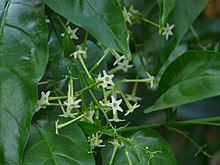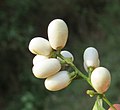Cestrum nocturnum
 From Wikipedia the free encyclopedia
From Wikipedia the free encyclopedia
| Cestrum nocturnum | |
|---|---|
 | |
| Scientific classification | |
| Kingdom: | Plantae |
| Clade: | Tracheophytes |
| Clade: | Angiosperms |
| Clade: | Eudicots |
| Clade: | Asterids |
| Order: | Solanales |
| Family: | Solanaceae |
| Genus: | Cestrum |
| Species: | C. nocturnum |
| Binomial name | |
| Cestrum nocturnum | |
Cestrum nocturnum, the lady of the night, night-blooming jasmine, night-blooming jessamine, night-scented jessamine, night-scented cestrum or poisonberry,[2] is a species of plant in the potato family Solanaceae. It is native to the West Indies, but naturalized in South Asia.[3]
Despite its common name, the species is not a "true jasmine" and not of the genus Jasminum.
Description
[edit]
Cestrum nocturnum is an evergreen woody shrub with slender branches growing to 4 m (13 ft) tall. The plant is multi-branched and heavily foliated. The leaves are simple, narrow lanceolate, 6–20 cm (2.4–7.9 in) long and 2–4.5 cm (0.79–1.77 in) broad, smooth and glossy, with an entire margin. Towards the front they are pointed or tapered, the base is rounded or blunt. The leaf stalks are 0.8 to 2 cm long.
Inflorescences
[edit]The flowers are greenish-white, with a slender tubular corolla 2–2.5 cm (0.79–0.98 in) long with five acute lobes, 10–13 mm (0.39–0.51 in) diameter when open at night, and are produced in cymose inflorescences. A powerful, sweet perfume is released at night. The mostly multi-flowered, drooping inflorescences are terminal or axillary. They are clustered, sparsely branched panicles, on the inflorescence axes of which there are herbaceous bracts. The five sepals are fused to form a bell-shaped, approximately 2 mm long calyx and have five pointed tips, which are slightly enlarged, ribbed and acutely pointed on the fruit. The inside and outside of the calyx are finely haired.
The fruit is a white berry 10 millimetres (0.39 in) long by 5 mm (0.20 in) diameter. There is also a variety with yellowish flowers. There are mixed reports regarding the toxicity of foliage and fruit.[4][5]
Cultivation
[edit]Cestrum nocturnum is grown in subtropical regions as an ornamental plant for its flowers that are heavily perfumed at night. It grows best in average to moist soil that is light and sandy, with a neutral pH of 6.6 to 7.5, and is hardy to hardiness zone 8. C. nocturnum can be fertilized biweekly with a weak dilution of seaweed and fish emulsion fertilizer.
Chemistry
[edit]Flowers distilled oil contains phenylethyl alcohol (27%), benzyl alcohol (12%), eicosane (5.6%), eugenol (5.6%), n-tetracosane (4.4%), caryophyllene oxide (3.1%), 1-hexadecanol (2.7%), methoxyeugenol (2.45%), benzaldehyde (2.32%).[6] Flowers alcohol extract contains cytotoxic steroids.[7]
Pharmacology
[edit]Toxicity
[edit]Ingestion of C. nocturnum has not been well documented, but there is some reason to believe that caution is in order. All members of the family Solanaceae contain an alkaloid toxin called solanine,[8] though some members of the family are routinely eaten without ill-effect. The most commonly reported problems associated with C. nocturnum are respiratory problems from the scent, and feverish symptoms following ingestion.[9]
Some people, especially those with respiratory sensitivities or asthma, have reported difficulty breathing, irritation of the nose and throat, headache, nausea, or other symptoms when exposed to the blossom's powerful scent.[10] Some Cestrum species contain chlorogenic acid, and the presence of this potent sensitizer may be responsible for this effect in C. nocturnum.
Some plant guides describe C. nocturnum as "toxic" and warn that ingesting plant parts, especially fruit, may result in elevated temperature, rapid pulse, excess salivation and gastritis.[11]
Spoerke and Smolinske (1990)[12] noted the following: "Ingesting 15 lb of plant material caused a cow to salivate, clamp its jaws, collapse, and eventually die. A postmortem showed gastroenteritis and congestion of liver, kidneys, brain, and spinal cord. Although the berries and the sap are suspected of being toxic,[13] several cases of ingestion of the berries have not shown them to be a problem, with one exception. Morton[14] cites two cases where children ate significant quantities (handfuls) of berries and had no significant effects and another two where berries were ingested in smaller amounts, with similar negative results", and in a new paragraph noted that "Ingestion of green berries over several weeks by a 2-year-old child resulted in diarrhea, vomiting, and blood clots in the stool. Anemia and purpura [discoloration of the skin caused by subcutaneous bleeding] were also noted. A solanine alkaloid isolated from the stool was hemolytic to human erythrocytes."[15]
Plant extracts have shown larvicidal activity against the mosquito Aedes aegypti while showing no toxicity to fish.[16][17] Plant extracts cause hematological changes in the freshwater fish when exposed to sub lethal concentrations.[18][19]
Psychoactivity
[edit]The mechanisms of the plant's putative psychoactive effects are currently unknown, and anecdotal data are extremely limited and include an aphrodisiac power.[20] In a rare discussion of traditional entheogenic use of the plant, Müller-Ebeling, Rätsch, and Shahi describe shamanic use of C. nocturnum in Nepal.[21] They describe experiencing "trippy" effects without mentioning unpleasant physical side effects. Rätsch's Encyclopedia of Psychoactive Plants also describes a handful of reports of ingestion of the plant without mentioning serious adverse side effects.
Invasive potential
[edit]Cestrum nocturnum has become widely naturalized in tropical and subtropical regions throughout the world, including Australia, New Zealand, South Africa, southern China and the southernmost United States, and is difficult to eradicate. It is classed as a weed in some countries.
In Auckland, New Zealand, it has been reported as a seriously invasive weed to the Auckland Regional Council and is under investigation. NS Forest and Bird is compiling an inventory of wild cestrum sites in order to place the plant on the banned list. The inventory can be viewed via Google Maps.[22] Some nurseries still sell it without warning customers of the dangers to native bush reserves.[citation needed]
Gallery
[edit]- Cestrum nocturnum buds
- Cestrum nocturnum fruit
References
[edit]- ^ Botanic Gardens Conservation International (BGCI), IUCN SSC Global Tree Specialist Group.; Meave, J.A. (2019). "Cestrum nocturnum". IUCN Red List of Threatened Species. 2019: e.T72045868A136785819. doi:10.2305/IUCN.UK.2019-2.RLTS.T72045868A136785819.en. Retrieved 19 November 2021.
- ^ "Cestrum nocturnum". European and Mediterranean Plant Protection Organization (EPPO). Retrieved 19 November 2020.
- ^ Hortus Third Cornell University, Western Garden Book 2007 Ed
- ^ Medicinal and Poisonous Plants of Southern and Eastern Africa – Watt & Breyer-Brandwijk (1962)
- ^ Erowid Cestrum Vaults : Cestrum Health Concerns. Erowid.org (2008-08-27). Retrieved on 2011-07-10.
- ^ Al-Reza, Sharif M.; Rahman, Atiqur; Kang, Sun Chul (June 2009). "Chemical composition and inhibitory effect of essential oil and organic extracts of Cestrum nocturnum L. on food‐borne pathogens". International Journal of Food Science & Technology. 44 (6): 1176–1182. doi:10.1111/j.1365-2621.2009.01939.x.
- ^ Wu, Deng-Pan; Lin, Tian-Yu; Lv, Jin-Yan; Chen, Wen-Ya; Bai, Li-Ru; Zhou, Yan; Huang, Jin-Lan; Zhong, Zhen-Guo (2017). "Flower Extracts Attenuate Proliferation and Induce Apoptosis in Malignant Cells through Inducing DNA Damage and Inhibiting Topoisomerase II Activity". Evidence-Based Complementary and Alternative Medicine. 2017: 1456786. doi:10.1155/2017/1456786. PMC 5307125. PMID 28250789.
- ^ What is solanine. Wisegeek
- ^ "Night blooming jessamine (Cestrum nocturnum) | Queensland Poisons Information Centre". 18 July 2017.
- ^ Department of Primary Industries, NSW Government, Reviewed 2021"NSW WeedWise".
- ^ The University of Arizona, Cochise County Master Gardeners, Cestrums (jessamine), Barbara Shelor, Nov. 1991"Common Poisonous Plants | Cochise County Master Gardeners".
- ^ Spoerke DG, Smolinske SC (1990). Toxicity of Houseplants. Boca Raton: CRC Press. ISBN 0-8493-6655-0.
- ^ Lampe KF, McCann MA (1985). AMA Handbook of Poisonous and Injurious Plants. Chicago: American Medical Association. ISBN 0-89970-183-3.
- ^ Morton JF (1971). Plants Poisonous to People in Florida and Other Warm Areas. Miami: Hurricane House.
- ^ Fruthaler GJ (1955). "Solanine poisoning". Ochsner Clinic Reports. 1 (2): 50–52.
- ^ Patil CD, Patil SV, Salunke BK, Salunkhe RB (2011). "Bioefficacy of Plumbago zeylanica (Plumbaginaceae) and Cestrum nocturnum (Solanaceae) plant extracts against Aedes aegypti (Diptera: Culicide) and nontarget fish Poecilia reticulata". Parasitol Res. 108 (5): 1253–1263. doi:10.1007/s00436-010-2174-6. PMID 21107859. S2CID 35903438.
- ^ Chetan Jawale; Rambhau Kirdak; Laxmikant Dama (2010). "Larvicidal activity of Cestrum nocturnum on Aedes aegypti". Bangladesh Journal of Pharmacology. 5 (1): 39–40. doi:10.3329/bjp.v5i1.4714.[permanent dead link]
- ^ CS JAWALE, LB DAMA (2010). "Haematological Changes In The Fresh Water Fish, Exposed To Sub-Lethal Concentration Of Piscicidal Compounds From (Fam: Solanaceae)". National Journal of Life Sciences. 7 (1): 82–84.
- ^ Jawale C. S.; Vinchurkar A. S.; Dama L. B., Pawar (2012). "Cestrum nocturnum (l) a prospective piscicide for control of predatory fish channa punctatus (bloch.)". Trends in Fisheries Research. 1 (2): 14–17.
- ^ Silvia Marchetti (6 October 2020). "Italian islands become 'sex pilgrimage' sites". CNN Travel.
- ^ Müller-Ebeling, Claudia; Rätsch, Christian; Shahi, Surendra Bahadur (September 2002). Shamanism and Tantra in the Himalayas. ISBN 0892819138.
- ^ Cestrum wild locations – Google Maps. Maps.google.co.nz. Retrieved on 2011-07-10.
Further reading
[edit]- Huxley, A., ed. (1990). New RHS Dictionary of Gardening. Macmillan.
- Poisons Information Centre (Queensland): Cestrum nocturnum
- Floridata: Cestrum nocturnum






